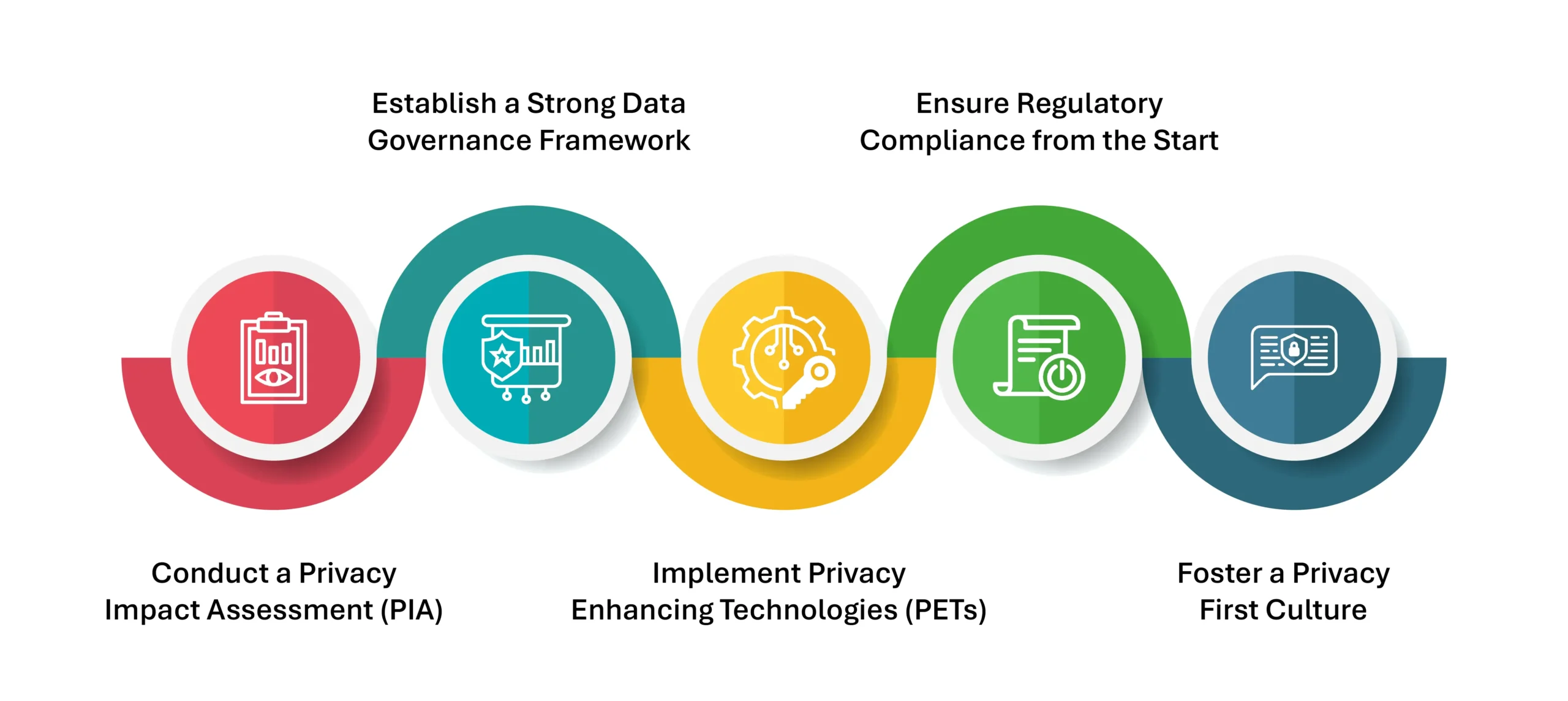What is Data Privacy by Design?
Data Privacy by Design (PbD) is a strategic framework that integrates privacy considerations into the architecture, design, and operations of systems, processes, and technologies from the outset rather than as an afterthought. The concept is built on the premise that privacy should be a default setting, embedded into technology and business processes to protect individuals’ data rights proactively.
Why Data Privacy by Design is the Strategic Imperative in the AI Era
The AI era is defined by data abundance, hyper-automation, and the rapid scaling of machine intelligence—but at its core, AI is only as powerful as the data it consumes. Without structured governance and embedded privacy controls, AI systems can quickly become liabilities, exposing businesses to regulatory fines, ethical concerns, and data security risks. Privacy by Design is not just about compliance; it’s about future-proofing AI-driven enterprises, ensuring responsible data use while maintaining a competitive edge in an increasingly privacy-conscious world.
One of the biggest risks in today’s AI landscape is data contamination—where unstructured, unvetted, or non-compliant data infiltrates AI models, leading to flawed outputs, bias, and security vulnerabilities. Privacy by Design ensures data integrity from ingestion to decision-making, embedding traceability, anonymization, and role-based access control (RBAC) into AI pipelines. This proactive approach enables organizations to maintain control over data provenance, eliminating the risk of AI hallucinations and privacy breaches before they happen.
Regulatory crackdowns are shifting from reactive penalties to proactive enforcement, and organizations that treat privacy as a last-mile problem will struggle to keep up. Laws like GDPR, CCPA, and the DPDP Act now mandate explainability and user-centric control over data usage, directly impacting AI systems that rely on black-box decision-making. Embedding Privacy by Design ensures that AI models operate with ethical guardrails, dynamically enforcing compliance policies without disrupting innovation or operational agility.
Trust is no longer a marketing buzzword—it is the currency of AI adoption. Enterprises deploying AI for automated decision-making in finance, healthcare, and critical infrastructure must recognize that users are growing wary of opaque AI systems. A Privacy by Design framework ensures AI decisions are transparent, auditable, and explainable, allowing businesses to build consumer confidence while differentiating themselves in a data-sensitive market. Companies that lead with privacy will own the trust narrative, while those who ignore it will face an uphill battle in AI-driven ecosystems.
Strategically, Privacy by Design is not a compliance cost—it’s an AI enabler. It allows organizations to unlock AI at scale by ensuring that data remains usable, secure, and ethically governed. Enterprises that proactively implement privacy-first AI architectures will gain faster regulatory approvals, reduce AI governance overhead, and avoid the operational risks of unstructured, non-compliant data. The future of AI is not just about intelligence; it’s about intelligent privacy.
5 Crucial Steps Before Implementing Data Privacy by Design

- Conduct a Privacy Impact Assessment (PIA)
Before embedding privacy into systems, companies must assess existing risks, data workflows, and compliance gaps. A thorough PIA helps identify what data is being collected, how it’s processed, where it flows, and what regulatory frameworks apply. This assessment provides a clear understanding of vulnerabilities and informs the design of privacy-first architectures.
- Establish a Strong Data Governance Framework
Data privacy cannot exist without robust governance. Companies should define clear policies, assign accountability to data protection officers and security teams, and implement metadata-driven governance. Enforcing structured access control mechanisms and data retention policies ensures compliance and prevents unauthorized data exposure.
- Implement Privacy-Enhancing Technologies (PETs)
Privacy should be integrated at the technical level through encryption, anonymization, differential privacy, and automated consent management. These technologies ensure that personal data is protected throughout its lifecycle, whether at rest, in transit, or during processing. Organizations should also adopt AI-driven monitoring tools to detect anomalies and prevent privacy breaches.
- Ensure Regulatory Compliance from the Start
Companies must embed compliance with global data privacy regulations like GDPR, CCPA, and DPDP Act into their operational framework. This means implementing privacy-by-default settings, automating data subject access requests, and ensuring cross-border data transfer compliance. A compliance-first approach reduces legal risks and strengthens digital trust.
- Foster a Privacy-First Culture
Technology alone cannot guarantee data privacy; employees must be trained to uphold privacy principles. Organizations should invest in privacy awareness programs, secure development practices, and role-based training. Encouraging a Zero Trust security mindset and continuous education ensures that privacy is maintained across all levels of the company.
In the AI era, where data fuels innovation, privacy by design is more than a regulatory requirement—it’s a business differentiator. Organizations that integrate privacy-first principles into their AI and data strategies will not only mitigate risks but also build trust-driven, scalable, and future-proof ecosystems. As AI models become more embedded in decision-making across industries, ensuring data integrity, security, and ethical governance will separate industry leaders from those struggling with compliance and reputational fallout. By making privacy a core foundation rather than a reactive fix, businesses can unlock AI’s full potential while safeguarding the rights and expectations of their customers. In the end, intelligent AI must be built on intelligent privacy—anything less is a risk not worth taking.
Industry Insights & Trends:
- 86% of the US general population say data privacy is a growing concern for them.
- 95% of organizations say the benefits of investing in data privacy exceed costs, with the average organization realizing a 1.6x return on their privacy investment. 30% of organizations estimate a 2x ROI on data privacy investment.
- 61% of users agree that privacy policies are ineffective at explaining how companies use their data. 69% say they view these policies as just something to get past.
Getting Started with Data Dynamics:
- Read the latest IDC Spotlight Paper – Rethinking Data Security: Improving Privacy and Compliance with a Shared Approach
- Learn about Unstructured Data Management
- Schedule a demo with our team






